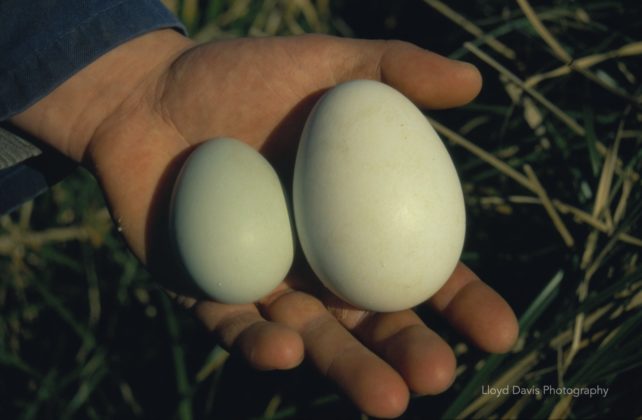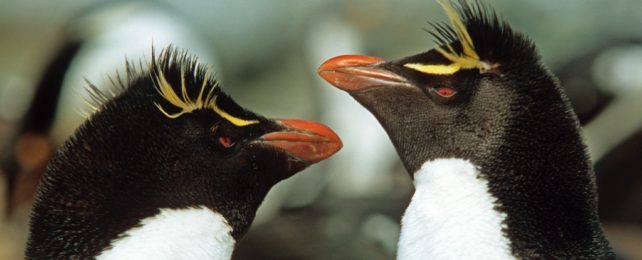The least studied penguins in the world lay two eggs each breeding season, only to abandon the first one.
Most of the time, the initial egg laid by erect-crested penguins (Eudyptes sclateri) simply rolls away. But sometimes, the female will purposefully ditch their first born, going so far as to push it out of the nest.
The bizarre behavior was first observed in 1998, and only now do the researchers who first conducted the fieldwork on the penguin's remote, uninhabited islands think they understand what's going on.
A reanalysis of the old data suggests these subantarctic penguins, whose numbers have declined sharply in the last 50 years, are forced into direct and indirect infanticide because they cannot find the same amount of krill and squid as their ancestors.
Since the first egg the penguins lay is much smaller than the second, the mothers choose to keep the latter. Although there are a few theories, the researchers behind this new study suspect the earlier egg is smaller because it is formed while the birds are still migrating to their breeding islands off the southern coast of New Zealand. The second one is laid about five days after the first.
Though common to all seven species of crested penguins, the egg size difference is highly unusual for most birds. In other species where females 'hedge their bets' for egg survival by producing more than one, it's the first egg that tends to be larger.

The data on the erect-crested penguins is obviously several decades old, but these birds are scientifically overlooked, probably because of their remote habitats.
Today, the birds are endangered, which isn't helped by the fact so little is know about them. The researchers say the 1998 study is still "by far the most detailed data available on this species."
Understanding how these birds breed is crucial to their conservation. If scientists are right, these penguins may be suffering from an evolutionary hangover that no longer proves useful in the modern world – and are doing their best to adapt.
With more food available to the mother penguin, 'egg B' has features that give it an inherent advantage over the earlier-laid 'egg A'. It is larger, and these penguins tend to put the larger one at the back of the brood patch when they are incubating their eggs.
Egg B's size also indicates to the mother that the chick may provide it with more sustenance, giving it a better chance of survival.
Of all 113 nests studied by researchers in 1998, about 80 percent of A-eggs were lost before or on the day that egg B was laid. The rest were lost within a week after that.
More than 90 percent of the time, the eggs were just laid directly onto the ground; only sometimes were they squeezed onto a mat of straw-like dried grass.
Researchers at the time decided to experiment with penguins breeding in another colony nearby.
To do this, the team placed a ring of stones around 14 'nests' to stop the A-eggs from rolling away, as they usually seem to do, especially when B-eggs are added to the mix.
Compared to 28 nests left untouched, A-eggs in the manipulated nests did not survive any longer. In both groups, all of the initial eggs were lost.
When the human-made ring of stones was present, however, nearly 65 percent of the A-eggs were found broken in the nest. In the untouched group, the eggs were found rolled away, while others had gone missing entirely, probably rolling off the slope of the island's plateau where the colony was breeding.
Many of the birds studied didn't even bother to incubate egg A while it was there.
"Together with very low copulation rates, which are an order of magnitude less than comparably-sized Adelie penguins and low levels of fighting during the courtship period, this points to low levels of reproductive readiness amongst erect-crested penguins arriving at the colony for breeding," the authors conclude in their new paper.
The findings are at odds with two of the main hypotheses on the penguin's penchant for parental rejection.
One, suggests A-eggs are lost to fighting during the courtship period, which doesn't seem to be true based on behavior and hormone levels.
The other hypothesis suggests that the first-laid eggs act as insurance against the loss of larger second-born.
But this too is unlikely, researchers argue. Erect-crested penguins are derived from ancestors that also laid two eggs, and theoretically, if food became less available over time, natural selection could act to reduce the clutch size. In other words, the birds would stop laying a second egg.
Yet selection seems to favor the second egg, for the reasons outlined before.
"It being physiologically impossible to have a second egg without laying a first egg, the best the crested penguins can do is reduce investment in the first egg," the authors explain.
"Erect-crested penguins do this to an extreme extent and have the largest egg-size dimorphism of all penguins, indeed, all birds."
That "such an intriguing and endangered penguin species should be so little known in this day and age" is a paradox, the researchers say.
It's also a downright shame.
The study was published in PLOS ONE.
